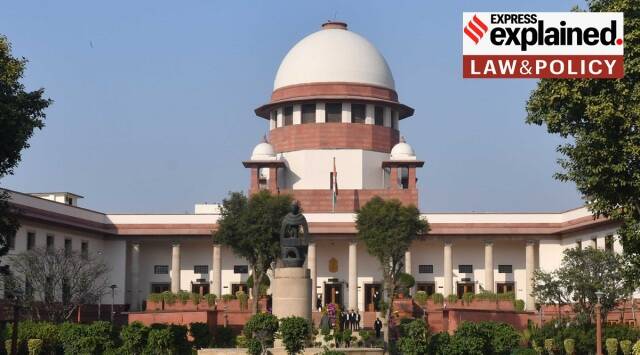Why the SC acquitted a man on death row for the rape and murder of six-year-old
The Supreme Court underlined 'yawning gaps' in the conviction of Prakash Nishad in Thane. Here's what the case was about.
 The SC found 'several irregularities and illegalities on the part of the agencies examining the case.' (PTI photo)
The SC found 'several irregularities and illegalities on the part of the agencies examining the case.' (PTI photo) The Supreme Court last week acquitted a man who had been on death row for the rape and murder of a six-year old girl, underlining “yawning gaps” from unlawful searches to unexplained delays.
Prakash Nishad had been awarded the death sentence in 2014 by the Thane sessions court, which was later was confirmed by the Bombay High Court. He spent 13 years in jail, of which nearly nine were on death row.
On May 21, the SC acquitted Nishad of all charges and directed his release. The Supreme Court said that the victim was caused grave trauma and pain as she had sustained 15 injuries, but the numerous lapses in the probe had led to the person who committed the offence remain unpunished.
What is the case about and what gaps did the SC find in the prosecution’s case?
What was the case before the Supreme Court?
On June 12, 2010, a six-year-old girl playing outside her home in Bhayander in Thane district went missing. Her family began looking for her. In a few hours, her body was found in a nearby nullah (drain). It was found that the girl had been raped before being murdered. As the family of the victim said that they did not suspect anyone who could commit the crime, an FIR was registered against an ‘unidentified person’ on charges of rape (376), murder (302) and destruction of evidence (201) of the Indian Penal Code.
On the next day, the police arrested a man named Prakash Nishad, who lived in the same vicinity as the victim. He was charged with the rape and murder of the six-year-old.
What happened during the trial and before the Bombay High Court?
In 2014, the sessions court in Thane found Nishad guilty of all charges and sentenced him to death for the murder of the girl. The appeal against the conviction and confirmation of the death penalty was heard by the Bombay High Court. The High Court too confirmed the death penalty, considering the grievous nature and severity of the crime. An appeal was then filed by Nishad before the Supreme Court.
During the proceedings of the case before the Sessions court and the High Court, the main evidence relied upon was the DNA evidence. The basis for the prosecution’s case was that Prakash was found near the crime scene and had made two disclosure statements leading to the discovery of incriminating articles, such as clothes belonging to him and the victim, from his house and “another place”.
Besides this, the prosecution relied on DNA reports to claim that the victim’s blood was found on Prakash’s vest and the semen on the victim’s clothes and vaginal smear slide matched his.
What did the Supreme Court say?
A Bench of Justices B R Gavai, Vikram Nath and Sanjay Karol found “several irregularities and illegalities on the part of the agencies examining the case.”
The statement of the accused: Observing this to be a case of circumstantial evidence, “as none has witnessed the crime” with which Prakash was charged, the court said the prosecution’s case was based on Prakash’s confessional statement. The Court found that Prakash’s statement was recorded in Marathi without the Investigating Officer (IO) ever reading or explaining its content to him in his language, Hindi. Thus, the court observed, “certainty is absent as to the correctness of the statement as made” and “as recorded by the police”. Relying on its 1953 Constitution bench ruling in “Syed Qasim Razvi v. State of Hyderabad”, the court said that not understanding the court’s language causes prejudice to the accused in his trial and “violates the equal protection clause in the Constitution.”
The court also observed that no clarity was given on how the accused was identified to be the culprit as nobody had witnessed him and the victim together or seen him at the spot. It said that the police had claimed that there were ‘certain inputs’ based on which the accused was arrested on the next day, but they were never revealed.
Illegal search: The court noted there was no evidence to show that the “incriminating articles” recovered from Prakash’s residence were owned nor exclusively possessed by him. Instead, the investigating officer later admitted that the said house was occupied and owned by two other people, both of whom were never examined in this case.
The ruling said that a search was conducted at the accused’s home on June 13, 2010, when no incriminating articles were found. Another search by a new investigating officer on June 16, 2010, led to the seizure of the shorts, vest with blood stains. The court said that when a thorough search was conducted the first time at the house of the accused, which was just a small room measuring 8.5 feet x 6.5 feet, the question of finding the incriminating articles in the second search does not arise.
The SC added that the law on circumstantial evidence was “well-settled” in light of the 1984 SC ruling in “Sharad Birdhichand Sarda v. State of Maharashtra”, holding that the circumstances “should be of a definite tendency unerringly pointing towards the guilt of the accused” and “form a chain so complete that there is no escape from the conclusion that within all human probability, the crime was committed by the accused”.
Broken chain of custody in DNA evidence: The court also observed the “unexplained delay” in sending the DNA samples pointed to their possible contamination. “There is nothing on record to establish as to who took such samples, on what date, on how many occasions, and why were they not sent all at once, we notice that none of the police officials have testified to the formalities of keeping the samples safe and secure being complied with,” the court said. Noting that “numerous lapses” had blotted “the entire map” which led to “the chain of circumstances remaining broken”, the court observed that the actual perpetrator of the crime could be unpunished till date.






- 01
- 02
- 03
- 04
- 05
































